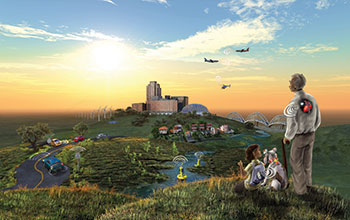Multimedia Gallery
Cyber-physical systems connect computation and the physical world
An artist's illustration showing how cyber-physical systems (CPS) can connect computation and the physical world. CPS are "smart" networked systems that are engineered to sense and interact with the physical world, and to support real-time performance in safety-critical systems. With CPS, the joint behavior of the "cyber" and "physical" elements of the system is critical. Computing, control, sensing and networking are deeply integrated throughout the system, and the actions of components and systems must be carefully orchestrated. Since 2008, NSF has invested more than $250 million to conduct the basic research that underlies all CPS systems.
More about this image
The following perspective was written in 2009 by Keith Marzullo, Division Director for Computer and Networked Systems at the National Science Foundation (NSF).
Imagine a world in which our physical environment interacts seamlessly and intelligently with us. Our homes and offices respond to our needs while conserving our use of resources such as energy and water; we have access to autonomous vehicles that provide transportation while reducing congestion, fuel costs and accidents; and we have medical implants personalized for our bodies and conditions that can communicate with our medical providers in a way that improves our health while maintaining our privacy.
Until recently, this kind of world existed only in the realm of science fiction, but no longer. Prototypes of the systems just described are being built in research labs around the world. We call such systems cyber-physical systems, or CPS for short. In 2008, NSF created a program to develop the engineering knowledge needed to build such systems, along with the necessary underlying scientific and mathematical techniques and the platforms that support their development and deployment.
CPS are "smart," networked systems that are engineered to sense and interact with the physical world, and to support real-time performance in safety-critical systems. With CPS, the joint behavior of the "cyber" and "physical" elements of the system is critical. Computing, control, sensing and networking are deeply integrated throughout the system, and the actions of components and systems must be carefully orchestrated.
Cyber-physical systems interact with people as well, both as users controlling them and as part of the environment in which the systems operate. Because these systems control aspects of the physical world, they are life critical. Such systems must be designed to be correct, which requires formal models, verification methods and the ability to be certified.
You can continue reading Marzullo's perspective on CPS Here. Or, see the NSF Special Report
Cyber-Physical Systems: Enabling a Smart and Connected World. (Date of Image: 2009)
Credit: Nicolle Rager Fuller, NSF
See other images like this on your iPhone or iPad download NSF Science Zone on the Apple App Store.
Images and other media in the National Science Foundation Multimedia Gallery are available for use in print and electronic material by NSF employees, members of the media, university staff, teachers and the general public. All media in the gallery are intended for personal, educational and nonprofit/non-commercial use only.
Images credited to the National Science Foundation, a federal agency, are in the public domain. The images were created by employees of the United States Government as part of their official duties or prepared by contractors as "works for hire" for NSF. You may freely use NSF-credited images and, at your discretion, credit NSF with a "Courtesy: National Science Foundation" notation.
Additional information about general usage can be found in Conditions.
Also Available:
Download the high-resolution JPG version of the image. (5.4 MB)
Use your mouse to right-click (Mac users may need to Ctrl-click) the link above and choose the option that will save the file or target to your computer.



